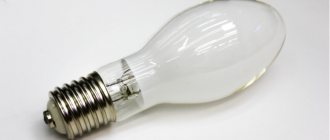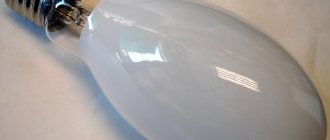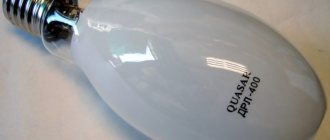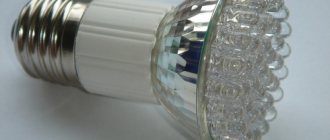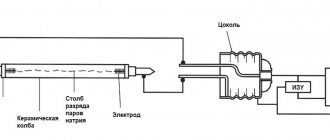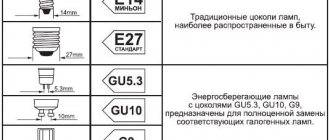Design
The design includes the following elements:
- glass container;
- threaded base;
- mercury-quartz burner filled with argon. Additionally, a drop of mercury is added;
- main cathodes;
- additional electrodes;
- additional carbon resistor.
Helpful information! The purpose of the additional electrodes is to facilitate lighting of the lamp. They are also responsible for stable operation.
The elements are discussed in more detail below:
- base It receives electricity from the network as a result of contact of the current-carrying parts of the lamp with the contacts of the lamp socket. As a result, electricity is transferred to the burner electrodes;
- quartz burner. It looks like a flask with two electrodes on each side (two are main, two are additional). The burner is filled with argon and a drop of mercury;
- glass flask. This is the outer part of the light bulb. Inside there is a burner with connected electrical conductors coming from the contact base. To pump nitrogen into the flask, all the air is first pumped out of it.
You may be interested in The problem of light bulbs burning out, how to fix it
The first models of DRL lamps had only two electrodes. Such lamps were more difficult to light - an additional starting device was required. The modern, throttle version is equipped with four electrodes.
Device
Alternative lighting sources
An energy-saving LED lamp is an excellent analogue to other lighting sources, including DRL; if you buy it, you can significantly save on electricity. Replacing street lighting will pay for itself after three years of operation, even taking into account the refurbishment work.
Many well-known foreign and Russian companies (for example, Lisma) are engaged in the production of these lighting devices. Currently, the price of these devices is slightly higher than the cost of a DRL lamp, but in the near future this problem will be eliminated, which will make LED lighting sources more accessible in Moscow, St. Petersburg, as well as in cities such as Saransk or Yekaterinburg.
Source
Disposal
The lighting devices in question are classified as hazard class 1. Therefore, the number of places where these are prohibited for use is now growing. It is possible that in a few years mercury lamps will be phased out everywhere, as government policies are aimed at reducing the amount of equipment containing mercury. In compliance with government orders, utilities are reducing their use of DRLs.
Unfortunately, not everyone thinks about the issues of decommissioning such light sources. By doing this, they harm not only themselves, but also those around them.
Soon their sale will be completely stopped. Devices containing mercury will be left only in medical equipment until a safe analogue is found.
Currently, recycling of mercury lamps is a licensed service. On September 3, 2010, a corresponding decree of the Russian government was adopted. The document describes the requirements for the disposal process and contains information on the procedure for dealing with mercury contamination. The process of demercurization - removal of mercury is described.
Now all legal entities of the Russian Federation are required to create a waste passport for fluorescent lamps and keep strict records of mercury-containing waste. The presence of mercury is already a potential danger.
Recycling and recycling refers to the recovery of used metals from devices containing them. Including mercury. A damaged flask will allow liquid metal to escape into the environment.
In Russia, the Federal Law No. 187 is in force (Article 139). According to it, a fine will be collected for improper disposal or placement of a hazardous waste container in an inappropriate place. Unauthorized removal from the storage area is also punishable.
Comparison of DRL light bulbs with analogues
Discharge lamps are often compared with each other and with more profitable LEDs. The closest analogues of DRL are three types of illuminators: DRI, DRI and DNAT. Let's try to identify the features and competitive advantages of different light bulbs.
DRV. A mercury-tungsten arc lamp is very similar in design and operating principle to a DRL. Structurally, inside the flask there is a mercury discharge torch and a tungsten spiral. The last element limits the current for the burner, which means that additional ballasts are not needed.
The main differences between mercury-tungsten lamps and DRLs:
- They consume more electricity - the luminous flux of DRV 250 is no more than 5500 Lm;
- estimated operating time – 3000 hours;
- lights up within 1 minute.
DRI. Mercury arc lamps with emitting additives: indium, sodium, thalium halide, etc. Metal components increase the light output of devices to 75-90 Lm/W.
An additional advantage of metal halide mercury lamps is improved color rendering. To operate DRI, like DRL, they require connection via a choke
DNAT. Sodium arc lamps boast the highest light output and longest operating life among discharge illuminators. The performance of sodium light bulbs does not decrease as noticeably over time as DRL lamps.
Characteristics of DNAT:
- maximum light output – 125 Lm/W;
- operability – within 20 thousand hours;
- relative stability of parameters;
- wide range of operating temperatures;
- reaching maximum illumination in 5-7 minutes.
Disadvantages of sodium light sources: significant pulsation and low color rendering coefficient, Ra=25. The emission spectrum is dominated by red and yellow colors.
Discharge lamps are confidently giving way to LED options. LED devices are superior to their predecessors in all technical and operational parameters.
The undeniable advantages of LEDs: environmental friendliness, minimal pulsation, service life, instant switching, excellent color reproduction and contrast. In addition to excellent performance characteristics, diode devices have temperature and mechanical resistance.
The efficiency of LED lamps is unrivaled, operating efficiency reaches 95-98%. The main factor somewhat constraining the re-equipment of lamps is the high price of LED lamps
Technology development
Technology has also improved. Metal halide lamps are now available. They have added iodine and other metal compounds to improve visible emission and color.
A new variety was created - DRV. This is a hybrid of a classic incandescent lamp and DRL. They have a tungsten filament added to them. It plays the role of a limiting resistor and a radiation source at the same time. The resistor is usually carbon. Here it is made of refractory tungsten. This design solution made it possible to abandon the use of a throttle. This lamp is connected like a regular incandescent lamp - it does not require additional ballasts.
Operating principle of the DRL lamp
The burner of the product is made of transparent, chemically resistant, refractory material - quartz glass or special ceramics. It is filled with a precisely measured dose of inert gas and a drop of metallic mercury. The luminous body in the structure is a column of arc electric discharge.
The principle of operation inherent in the DRL lamp looks like this. When electricity is supplied to the product, a glow discharge is formed between the main and ignition electrodes. The elements are located so close to each other that they provide a lower breakdown voltage. A glow discharge almost instantly becomes an arc discharge. The electrical and luminous qualities of the lamp become stable 10 - 15 minutes after energy is supplied. During this period, the current exceeds the rated values (the ballast is used for limitation). The starting mode largely depends on the ambient temperature - in cold weather the light bulb takes longer to “start”.
It is in the burner that all the action takes place
As a result of the electrical discharge in the burner, blue and violet radiation, including UV (ultraviolet) radiation, becomes visible. They provoke the glow of the phosphor located on the inner walls of the flask. The burner shines with white-green light, the phosphor - reddish. The shades are mixed and the result is a bright color close to white.
If the voltage fluctuates in the electrical network, this is reflected in the luminous flux. Permissible voltage deviations are from 10 to 15% (in this case, the luminous flux will fluctuate by 25 - 30%). If the supply voltage drops to 80% of normal, the product simply will not light up. If it was on fire before, it will go out.
DRLs get very hot during operation. Because of this feature, it is necessary to carefully consider the design: use heat-resistant wires and high-quality contacts on the sockets. As the lamp heats up, the pressure in its burner increases, and with it the breakdown voltage. That is, the network voltage may not be enough to turn it on again. To restart the product, it needs time to cool down. This is the main drawback of DRLs - power surges simply extinguish them, and turning them on again requires a pause.
Additional Information! If the surrounding air is warm, the product will quickly reach the maximum light emission mode.
You might be interested in: Features of electronic ballast
Technical and operational characteristics
As the glass flask is heated, the mercury scattered on its surface (in the form of drops) begins to evaporate. The stronger the evaporation process, the stronger the discharge between the electrodes and cathodes. The nominal mode of the DRL lamp is the moment when all drops of mercury are converted into steam.
The product is characterized by increased sensitivity to temperature changes, so its functionality without a flask is impossible (based on physical laws).
The flask is responsible for two important functions:
- Barrier between the gas-discharge chamber with mercury vapor and the environment.
- Acceleration of the process of converting ultraviolet rays into a red light spectrum, which is possible due to the presence of phosphor on the walls. To the red glow is added green, generated by an internal discharge, which leads to the appearance of white light.
Voltage surges greatly affect the operation of the DRL lamp. A deviation from the nominal value of 10–15% is considered acceptable, but if this value is equal to 25–30%, the glow will become uneven. With an even greater reduction, the lamp will either not light up or go out (if it was in operation before).
Decoding product markings is very simple - the number indicates the lamp model, which coincides with the rated power.
The table below shows the parameters of specific DRL models:
| Model | Rated voltage, V | Power, W | Length, mm | Diameter, mm | Base | Luminous flux, lm | Durability, h |
| DRL-125 | 125 | 125 | 177 | 77 | E27 | 6000 | 12 000 |
| DRL-250 | 130 | 250 | 227 | 90 | E40 | 13 500 | 15 000 |
| DRL-400 | 135 | 400 | 290 | 121 | E40 | 25 000 | 18 000 |
| DRL-700 | 140 | 700 | 356 | 151 | E40 | 40 000 | 20 000 |
| DRL-1000 | 145 | 1000 | 412 | 168 | E40 | 60 000 | 18 000 |
Design and principle of operation of DRL
To coordinate the technical characteristics with the power source, ballasts are used in all types of mercury lamps, allowing you to connect a DRL lamp. Most lighting devices are started by a choke, which is connected in series with the light bulb.
A classic DRL lamp consists of main electrodes, ignition or additional electrodes, lead-in parts of the electrodes, special gas, posistors and mercury. Argon is used as a gas, which produces initial ionization and contributes to the formation of an arc discharge. Argon is also called a buffer gas. Using posistors, the current of the igniting electrodes is limited. Mercury is used to change the potential during discharge.
The main functional parts of a conventional DRL
- A base that directly receives electricity from the network. Its contacts are point and threaded, connected to the contacts of the cartridge. Thus, alternating current is supplied to the lamp electrodes.
- The quartz burner is the main part. It is made in the form of a flask with four electrodes located on the sides, including two of them - the main ones, and the other two - additional ones. The space inside the burner is filled with argon to prevent heat transfer, as well as a small amount of mercury.
- The glass bulb is the outer part. It houses a quartz burner inside, to which conductors are connected from the base. Instead of air, nitrogen is pumped into the flask. The inside of the flask is coated with a phosphor.
The operating principle of DRL is quite simple. Power is supplied from mains voltage. After the DRL lamp has been connected, the electric current begins to reach the gap between both pairs of electrodes located at opposite ends of the lamp. A small distance between them promotes rapid ionization of the gas. First, the gas is ionized between the igniting electrodes, then the current flows to the main electrodes and at the end of this process the lamp begins to emit light.
The lamp begins to glow fully after approximately 7-10 minutes. This period of time is required to heat up the mercury located in the form of a deposit or clot on the inner walls of the flask. During operation, the service life of the lamps gradually decreases, and the period required for full activation increases.
The burner is made of transparent material - quartz glass, filled with inert gases in strictly defined doses. Mercury introduced into the burner may have the form of a small ball, and also settles on the walls and electrodes in the form of plaque. The light source is an electric arc discharge.
The DRL lamp circuit is included in the general connection circuit via a choke. The choke brand must match the lamp power. The main purpose of the inductor is to limit the current flowing to the light bulb. If there is no choke, the lamp will instantly burn out, since the external electric current is too large for it. Typically, a capacitor is also added to the circuit, which affects the reactive power at startup, which allows you to save electricity almost twice.
We advise you to study - Organization and types of repair of electrical machines
The greatest glow occurs after approximately 6-7 minutes. This time is necessary to transform the mercury into a gaseous state, which improves the discharge between the electrodes. After this, the lamp goes into normal operating mode with the highest light output. After turning off the light bulb, it should not be turned on until it has completely cooled down.
Safety regulations
When using a lamp, you must follow some safety rules:
- Before installing the light bulb, you need to carefully unpack it and make sure there are no mechanical damages;
- It is prohibited to screw in or operate a faulty lamp; you also cannot use an open lamp in an open place where it is not protected from wind or precipitation;
The light bulb must be intact
- After installation, it is necessary to carry out a test by turning on the lamp for 10-15 minutes. After that it can be used. It is important to remember that DRV lamps take several minutes to light up;
Important! If the network voltage is higher than 220 V, the lamps will fail faster and their service life will end earlier.
- Any installation of the lamp must be carried out only with the electricity turned off;
- If the light bulb becomes dirty, wipe it with a dry soft cloth. Solvents or aggressive cleaning agents must not be used;
- The lamp can be placed in any position - both horizontally and vertically;
- Light bulbs should be stored in packaging, not dropped or broken, they should not be given to children or allowed to play with;
- It is necessary to dispose of lamps by handing them over to a collection point for mercury lamps.
Due to mercury vapor, disposal must be carried out at special points
If the light bulb does break, you must:
- Ventilate the room for at least 30 minutes, after leaving it;
- Wear disposable gloves and sweep all large parts into a bag using paper or cardboard;
- Use a wet sponge or tape to collect small pieces. Mercury must be collected moving from the edges to the center;
- At the very end, clean using chlorine.
It is necessary to clean up the mercury spill site with chlorine
DRV and DRL light bulbs are often used to illuminate streets, warehouses, workshops and construction sites. They are easy to install and use, easy to install and change, and provide good quality light. However, both lamps are classified as hazard class 1 due to their mercury content and should be used with caution.
Design features
What are DRL 250 lamps made of? Their characteristics include the presence of the following components:
- Nickel plated base.
- A resistor that provides voltage limiting.
- Molybdenum foils.
- Framework.
- Glass flask (the luminomorphic coating is actually applied to it).
- Lead wire.
- Tungsten coated main electrode.
- Nitrogen, which acts as a filler for the outer flask.
- Compressed junction of a quartz light source. The quartz burner is the main working element of the lamp.
By the way, the first models of the lamps described had only two electrodes. However, such a device significantly worsened the process of turning on and warming up the lighting point, as a result of which the presence of an additional starting element called a high-voltage pulse-type breakdown of the burner gap was required. This version of the lamp was very quickly recognized as ineffective and was replaced with a four-electrode version equipped with a choke, without which the operation of such a lamp is simply physically impossible - it will simply burn out the moment it is turned on.
How can you start a DRL lamp without a choke?
To operate an arc lamp without an additional device, you can go in several directions:
- Use a light source with a special design (DRV type lamp). A feature of lamps that can operate without a choke is the presence of an additional tungsten filament, which acts as a starter. The parameters of the spiral are selected according to the characteristics of the burner.
- Starting a standard DRL lamp using a voltage pulse supplied by a capacitor.
- Ignition of a DRL lamp using a series connection of an incandescent lamp or other load.
Ignition of a lamp using a serial connection of a boiler is presented in a video filmed for the channel “A little bit of everything”.
Purchase of a special model DRL 250
Direct-on lamps are available in the product lines of a number of companies:
- TDM Electric (DRV series);
- Lisma, Iskra (DRV series);
- Philips (ML series);
- Osram (HWL series).
The characteristics of some direct-on lamps are shown in the table.
| Parameter | DRV 160 | DRV 750 |
| Power, W | 160 | 750 |
| Flow, Lm | 8000 | 37500 |
| Base | E27 | E40 |
| Resource, hours | 5000 | 5000 |
| Color temperature, K | 4000 | 4000 |
| Length, mm | 127 | 358 |
| Diameter, mm | 77 | 152 |
Operating principle of the DRV lamp:
- At the initial stage of ignition of the lamp, the spiral provides a voltage at the cathodes within 20 V.
- As the arc ignites, the voltage begins to increase, reaching up to 70 V. In parallel, the voltage on the coil decreases, causing a decrease in the glow. During operation, the spiral acts as an active ballast, which reduces the efficiency of the main burner. Therefore, there is a decrease in luminous flux with equal power consumption.
Advantages of DRV lamps:
- the ability to operate in 50 Hz alternating current networks with a voltage of 220-230 V without additional starting devices and supporting discharge combustion;
- Possibility of use instead of incandescent lamps;
- short time to reach full power mode (within 3-7 minutes).
Lamps have a number of disadvantages:
- reduced luminous efficiency (compared to conventional DRL lamps);
- resource reduced to 4000 hours, determined by the life of the tungsten filament.
Due to the disadvantages, DRV lamps are used in household lamps or in old industrial installations intended for the installation of powerful incandescent lamps. In this case, the devices improve illumination while reducing energy consumption.
Using a capacitor
When using lamps of the DRI type, starting is performed through an IZU - a special device that gives an ignition pulse. The composition includes a series-connected diode D and a resistance R, as well as a capacitor C. When voltage is applied to the capacitor, a charge is formed, which is supplied through the thyristor K to the primary winding of the transformer T. An increased voltage pulse is formed on the secondary winding, which ignites the discharge.
Capacitor ignition circuit
The use of elements allows you to reduce energy consumption by 50%. The connection diagram is identical; a dry-type capacitor is installed in parallel, designed to operate in circuits with a voltage of 250 V.
The capacitor capacity depends on the operating current of the chokes:
- 35 uF at current 3A;
- 45 microfarads at a current of 4.4A.
Using an incandescent lamp
To ignite the DRL, an incandescent lamp with a power equal to a gas-discharge lamp can be connected. It is possible to turn on the lamp by using a ballast resistor with the same power (for example, a boiler or an iron). Such methods do not provide stable operation and do not meet safety requirements, therefore they are not recommended for use.
Ignition of DRL 250 using an incandescent lamp with a power of 500 watts is demonstrated by the author Andrey Ivanchuk.
The appearance of a reactive load in the network has the following negative consequences:
Each inductor has its own capacitor capacity. These capacitors are not indicated either on the choke, or on the IZU, or on the lamp switching circuits. These capacitors are connected in parallel to the 220 volt network before the choke and serve to increase the cos F of the network, i.e. for reactive power compensation.
Initially, the electromagnetic choke has a very low cos F. On the throttle body, a parameter is indicated as “lambda” 0.42 (0.44), 0.55 is the modern designation of cos F, i.e. foreign electrical engineers, and ours too, have recently introduced a new concept for lighting calculations - “power factor”; it should be taken in calculations as cos F. Roughly speaking, the efficiency of the inductor is initially within 50%. This is very little, almost 50% of the electricity consumed is wasted, and you have to pay for false current.
When using an input capacitor (in parallel with the network), the inductor inductance is compensated by the capacitance and the current consumed by the lamp-choke set is reduced by almost 2 times. It is believed that with electromagnetic ballasts it is possible to obtain cos Ф, in the best case, no more than 0.92.
Electronic ballasts give cos Ф 0.98-0.99, i.e. the current will approach the current of a conventional 250-watt incandescent lamp (if there were such a thing). For example, the current consumed from the network of an electromagnetic ballast with a DNAT-250 lamp without a capacitor is almost 3A, and with it - 1.4A. And so on.
To obtain the required capacitance, capacitors can be connected in parallel, for example, 2 capacitors of 16 microfarads each, connected in parallel, give a capacitance of 32 microfarads, the operating voltage remains the same - 250 volts.
You should not hope that by installing a larger capacitance, you will get cos Ф greater than 1. If the capacitance is larger than necessary, the lamp will start blinking, if less, then the current consumption will decrease slightly. That is, increasing the capacitance of the capacitors will lead to a decrease in efficiency and the occurrence of resonance in the circuit.
Below are the capacitance values in the MCF (all capacitors must be designed for alternating voltage ~400V).
Design and principle of operation
A mercury gas discharge lamp, as its name suggests, is an electric light source that uses a gas discharge in mercury vapor to generate optical radiation. However, the adjective “luminescent” appears in the same name. This is due to the fact that to correct the color of the flux, the DRL lamp, in addition to the light from the gas discharge itself, uses the radiation of a phosphor that glows under its influence, which coats the inner surface of the lamp bulb. This makes the spectrum more uniform and wider and, as a result, improves color rendition.
It is known that for a discharge to occur in a gas, a high voltage must be applied between two electrodes, much greater than the standard 220 V. When a discharge already exists, it can be maintained at mains voltage. However, the smaller the distance between the electrodes, the less voltage is required to ignite the discharge. However, a small luminous area will not provide sufficient radiation power.
Therefore, in the first DRL lamps, the discharge was created using an external source of high voltage pulses, which pierced the working space between the electrodes when the lamp was turned on, and then the generator was turned off. Today, such a scheme has been returned to in sodium and metal halide gas-discharge lamps. However, at the time of the advent of mercury light sources (1960-70), such electronic devices were not reliable enough, so engineers had to look for another solution. Here we remembered the possibility of igniting a discharge using mains voltage at a small distance between the electrodes.
Since the 1970s, two additional ignition electrodes have been introduced into the design of mercury lamps, which are located very close to the main ones and are connected to opposite main electrodes through current-limiting resistors. Thus, when the lamp is turned on, two small glow discharges initially appear at each end of the burner, which gradually heat the entire volume of gas and ignite the main arc of the discharge (initially, this discharge is also glowing, but quickly turns into an arc). That is why the DRL’s paws do not immediately begin to glow brightly and for the first few minutes they “smolder” barely noticeably. In this case, the duration of the start-up mode strongly depends on the ambient temperature - the lower it is, the longer the lamp will warm up. A steady arc discharge between the main electrodes causes operating current to flow through the lamp, and small discharges no longer participate in the lamp combustion process.
Structurally, the burner with four electrodes is designed in the form of an internal flask made of quartz glass or special transparent ceramics, filled with an inert gas argon with the addition of metallic mercury. When the lamp is turned off and not warmed up, the mercury is inside the burner in the form of a separate small ball, or settles on the walls of the flask and electrodes in the form of a deposit. The material of the burner flask is very refractory and chemically resistant, so it can withstand the conditions necessary for a discharge to occur. The burner is placed inside an outer large flask made of ordinary glass. Conductors made of thick nickel wire and limiting resistances welded to them are also located here.
An electrical discharge in mercury vapor creates radiation with a very uneven, intermittent spectrum. It contains seven spectral lines, three of which, and at the same time the most intense, lie in the ultraviolet range. It is under their influence that the phosphor applied to the inner walls of the large flask glows. The visible light from the discharge has a blue-green hue, while the phosphor glows a warmer, reddish light. The radiation from both emitting objects, mixing, gives a bright and even light, quite close to white.
Product details
DRL lamps (mercury arc lamp) are a light source that operates on the principle of optical radiation, which is generated by a gas discharge from mercury vapor. Today this is a fairly common lamp that has become widely used in a variety of fields. Today, such lamps are used to create lighting:
- at industrial facilities. These are excellent industrial lamps that create a good luminous flux and can work in various conditions;
- for outdoor lighting. Such lamps are placed on poles located along roads, pedestrian paths in parks and squares. Outdoor type lamps can withstand various climatic conditions and even sudden temperature changes;
- creating the required level of illumination in public premises;
- for home, etc.
Note! The most widespread are DRL type lamps (250 lamps are more often used than 400 lamps), as well as DNaT lamps, which are used for street lighting.
Street lamp
DRL lamps have an elongated shape, making them very similar to ordinary incandescent light bulbs. The product consists of the following components:
- metal base;
- glass flask;
- a tube containing mercury vapor. In the tube, mercury vapor is always under pressure. The tube is made of quartz glass.
This structure determines the special operating principle of such devices.
Principle of operation
After turning on the light source in the electrical network, voltage is supplied to the current-carrying parts of the lamp located in the base. Through an electrical circuit, voltage is supplied to the electrodes mounted in the burner, as a result of which a glow discharge appears between them. This is due to the formation of additional free electrons and ions on their surface.
As electrons and ions accumulate, the internal space of the gas discharge tube heats up, and the mercury begins to evaporate. This ensures a discharge mode between the electrodes, moving from a smoldering state to an arc one.
As the amount of mercury vapor increases, the brightness of the arc discharge increases.
Under normal operating conditions, the time it takes for the light source to reach the stated technical parameters is 4.0–5.0 minutes.
Modifications of DRL and DVR are no different in appearance
What is more profitable - E-40 60 W or DRL-250?
Yes, the cost of LED lamps, analogues of E-40 DRL-250, is noticeably higher and higher. But let’s make the following comparison: let’s say an E-40 60 W LED lamp is operated for 12 hours every day. Under standard conditions, it will work for about 11 years, consuming 3,000 kW/h of energy in 50,000 hours, which is the national average of 12,000 rubles (at the rate of 4 rubles per 1 kW).
At the same time, the energy consumption of a close analogue, DRL-250, can be calculated using the same formula: 50,000 hours * 250 W = 12,500 kW/h * 4 rubles = 50,000 rubles . Moreover, for 50,000 hours of operation you will need to change from 5 to 7 DRL-250 lamps. Also, do not forget that the DRL-250 starter also consumes a certain amount of electricity, so the actual consumption will ultimately be even higher - by 3-5 percent of the average calculation.
What is a throttle for?
The choke for DRL lamps is used for starting; there are different types of lighting devices on the market in which it is used:
- Fluorescent and ultraviolet lamps.
Ultraviolet lamp Various types of mercury arc lighting devices: DRT, DRL, DRIZ, DRSh, DRI.
Arc mercury lamps Arc sodium lamps: DNaMT, DNaS, DNaT. Arc sodium lamp All lighting devices have differences in the principle of obtaining light flux, there are other differences:
- different materials are used in their design;
- differ in the presence of chemical elements;
- inside the flasks there is pressure according to the own parameters of each lighting device;
- they differ in power and brightness of the light flux.
These types of lamps are united by the variable value of the starting current and resistance during the start-up process and further operation.
In order to limit the amount of operating current, different types of ballast are used in lighting devices of this type: electronic ballasts, ballasts and ballasts, which are inductor coils (chokes). At the moment of startup, each device of this type has a high resistance value; when the lighting device is ignited, a process of electrical breakdown occurs in the inert gas environment with which the lamp is filled (mercury or sodium vapor), and an arc discharge occurs.
During the process when the lamp is ignited, the ionized gas loses resistance from the arc discharge several tens of times, and for this reason the current increases and heat is released. If you do not limit the amount of current, it will instantly create a superheated gas environment, which will lead to breakdown of the lighting device and damage from the inside. To prevent this, a resistance (choke) is included in the lighting device circuit.
Physical parameters and connection diagram of the inductor
A DRL inductor connected in series has a reactance, the value of which depends on the inductor: one Henry passes one ampere of current when the voltage is one volt.
Throttle
The parameters of the inductor include:
- square of copper wire used;
- number of turns;
- what is the core and cross-sectional size of the magnetic circuit;
- what electromagnetic saturation.
The inductor has an active resistance, which is always taken into account when calculating the ballast for each type of lighting device of this type, taking into account its power; the overall dimensions of the inductor depend on this.
Let's consider a simple circuit for switching on the ballast, when the design of the DRL lamp provides (additional) electrodes for the process of occurrence of a glow discharge that turns into an electric arc.
DRL lamp connection diagram
In this case, inductance limits the amount of operating current in the lighting device.
Ballast for fluorescent lamps
Structurally, a fluorescent lighting device uses a ballast choke for starting; new types of this lighting device use electronic ballasts, this is an electronic type of ballast. The purpose of this device is to contain the increasing current value at one level, which maintains the required voltage on the electrodes inside the lighting fixture.
Connection
The connection diagram for DRL lamps is shown in the figure; note that the functionality of these lighting sources can only be checked by turning them on accordingly.
Connection diagram for mercury arc light source
Symbols on the diagram:
- EL1 – DRL device;
- C – non-electrolytic type capacitor (must be designed to operate with a voltage of at least 250V), serves to reduce electricity consumption by reducing reactive power;
Video: Connection diagram of the inductor to the DRL lamp
- L1 - throttle;
- F1 – fuse.
Each type of lamp needs a corresponding choke, its task is to reduce the current of the power source, connecting it directly will lead to their failure.
Photo of chokes
The capacitor capacity is selected according to the following table:
| Light source power (W) | Capacitor capacity (uF) |
| 125 | 12,0 |
| 250 | 25,0 |
| 400 | 32,0 |
Chokeless lighting devices (DRL), unlike DRL lamps, do not require a special switching circuit.
How LDS is structured and works
Structurally, the device is a sealed flask filled with inert gas and mercury vapor. The inner surface of the flask is covered with a phosphor, and electrodes are soldered into its ends. When voltage is applied to the electrodes, a glow discharge occurs between them, creating invisible ultraviolet radiation. This radiation affects the phosphor, causing it to glow.
Fluorescent lamp circuit
All these are LDS, working on the same principle.
For normal operation of a fluorescent lamp, two conditions must be met:
- Provide initial breakdown of the interelectrode gap (start).
- Stabilize the current through the light bulb so that the glow discharge does not turn into an arc discharge (work).
Start the lamp
Under normal conditions, the supply voltage is not enough for electrical breakdown of the interelectrode gap, so starting an LDS can only be done with the help of additional measures - heating the electrodes to start thermionic emission or increasing the supply voltage to values sufficient to create a discharge.
Until recently, the first method was predominantly used, for which the electrodes were made (and are made) in the form of spirals, like those found in ordinary incandescent light bulbs. At the moment of switching on, voltage is applied to the spiral using automatic devices (starters), the electrodes heat up, ensuring the ignition of the lamp. After starting the system, the starter is turned off and does not participate in further operation.
Starters for starting LDS at various voltages
Later, circuit solutions began to appear that did not heat the electrodes, but supplied them with increased voltage. After breakdown of the interelectrode gap, the voltage automatically decreases to the nominal value, and the lamp goes into operating mode. In order for LDS to be used with any type of starting devices, all of them to this day are made with electrodes in the form of incandescent spirals, each having two terminals.
Maintaining operating mode
If the LDS is directly plugged into a socket, then the glow discharge that begins after ignition will immediately turn into an arc, since the ionized interelectrode gap has very low resistance. To avoid this situation, the current through the device is limited by special devices - ballasts. Ballasts are divided into two types:
- Electromagnetic (throttle).
- Electronic.
The operation of electromagnetic ballasts (EMGPA) is based on the principle of electromagnetic induction, and they themselves are chokes - coils wound on an open iron core. This design has an inductive resistance to alternating current, which is greater, the higher the inductance of the coil. Chokes vary in power and operating voltage, which must be equal to the power and voltage of the lamp used.
Electromagnetic chokes (ballasts) for LDS with a power of 58 (top) and 18 W.
Electronic ballasts (EPG) perform the same function as electromagnetic ones, but limit the current using an electronic circuit:
Electronic ballast for fluorescent lamp
Another variety
HPS lamp
Another variety of such products are HPS lamps. The abbreviation DNaT stands for sodium arc tube lamp. The principle of operation of the DNAT lamp is almost similar to DRL lamps.
This type of lighting device includes a glass container. It contains a special “burner”, which looks like a cylindrical discharge tube. This pipe in HPS lamps is made of a special material (pure aluminum oxide). Inside the pipe is filled with sodium vapor, which is under high pressure. As with the operation of DRL, an arc is formed in HPS by passing an electric current through sodium vapor. In terms of power, DNAT is somewhat different from DRL. DNAT lamps come in the following capacities:
Working DNAT
- 70 W;
- 150 W;
- 250 W;
- 400 W.
At the same time, the most popular and widely used today are lamps with a power of 250 and 400 W.
It is worth noting that HPS lamps have a specific glow and create radiation of orange-yellow or golden-white shades. In general, for lighting, these lighting devices are used as often as DRL lamps. At the same time, it is believed that DNAT lamps are the most economical light sources. This fact explains the fairly widespread distribution of this type of lighting devices for creating lighting in a wide variety of rooms, as well as street lighting. To create street lighting, lamps with a power of 250 W are often used, especially for illuminating highways, airfields, train stations and tunnels at night. However, products with a power of 400 W are used extremely rarely for these purposes.
Advantages and negative qualities
What is good and what is bad about DRL 250 lamps? The characteristics of their development provide them with the following positive indicators:
- Very high light output compared to other lighting devices.
- No dependence on precipitation.
- An impressive service life, which can easily reach 20 thousand hours.
- The emission spectrum is very close to natural light.
- Small own dimensions.
The disadvantages of lamps are:
- Formation of ozone during operation.
- Quite a high price (such lamps are 5–7 times more expensive than a regular incandescent lamp).
- In some cases, tungsten analogues will have smaller dimensions than DRL.
- After several months of operation, the emitted light spectrum changes as the technical characteristics of the phosphor layer change.
- The presence of mercury forces users to dispose of lamps according to a special scheme, separately from other goods, things, and products.
- Switching on occurs with some delay, and it takes several minutes to achieve combustion at full power.
- The light from such lamps is of rather low quality.
- Very high flicker factor during operation.
- It is best to hang lamps at a height of at least four meters.
- Towards the end of its service life, the luminous flux of the device decreases significantly.
- The lamp can only operate on alternating current.
Scope of application
DRV lamps find a wide audience of grateful buyers, for whom their undoubted advantages are not diminished by shortcomings that are not too significant in many cases. By including a mercury-tungsten lamp in a regular lamp without any modifications, you can increase its luminous flux by one and a half to two times - after all, this lamp is still more economical than an incandescent lamp.
We should not forget that powerful “Ilyich light bulbs” have been withdrawn from widespread use for reasons of energy saving. DRV is an ideal light source for the most cost-effective retrofitting of old high-power lamps with improvement of all their indicators - energy consumption, light output, emission spectrum.
We list the main areas of application of mercury-tungsten lamps:
— interior lighting of large premises, both residential, office or industrial;
— external lighting on small streets, parking lots, piers, platforms, courtyards, car parks, gardening areas.
Consumers of lamps are both public organizations (city lights, housing and communal services, railways), and industrial enterprises or individuals.
